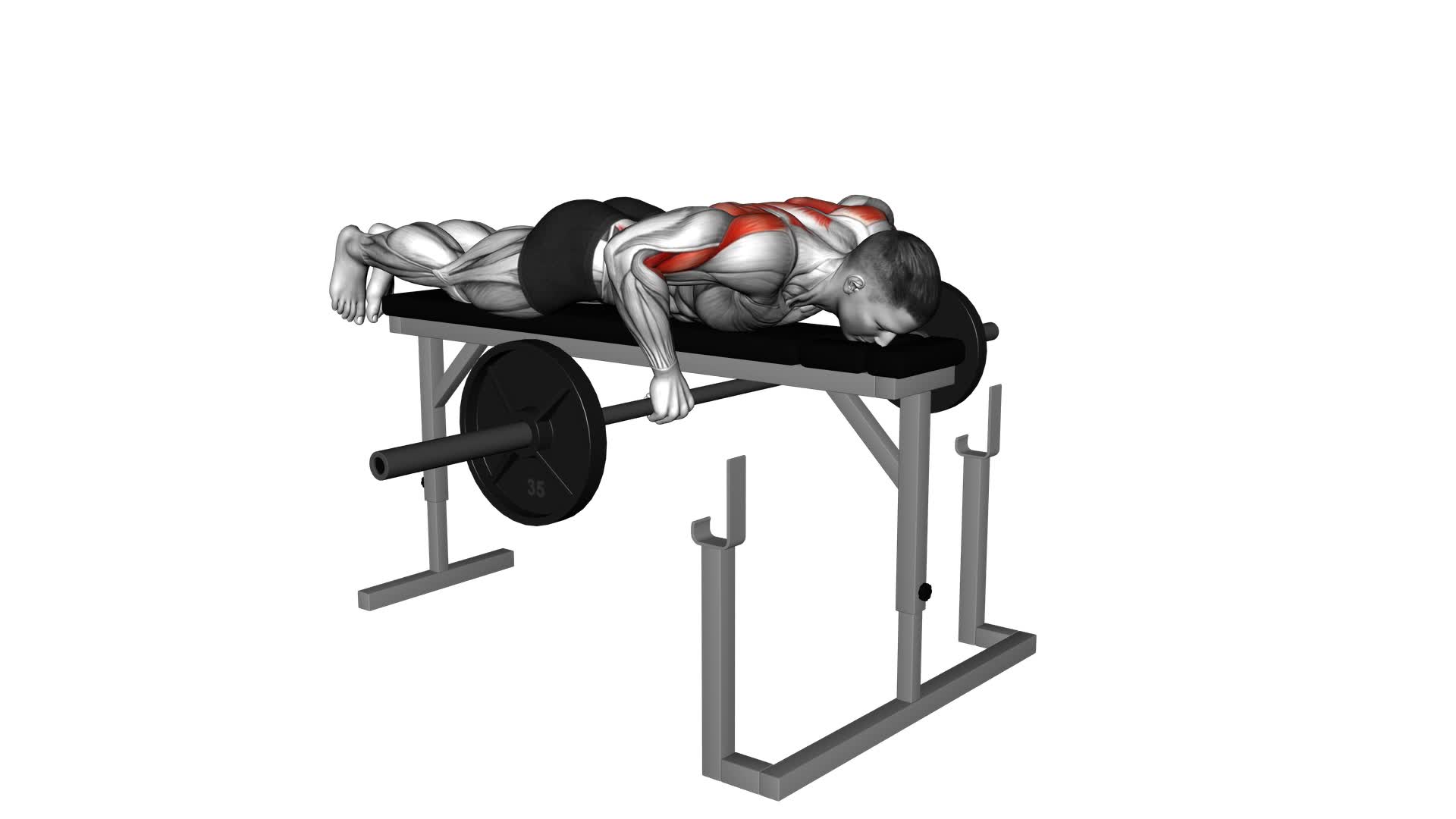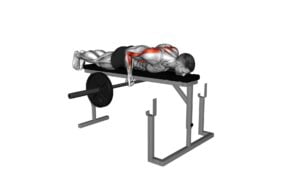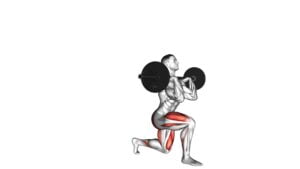Barbell Lying Row on Rack – Video Exercise Guide & Tips

Are you looking to strengthen your back muscles and improve your overall strength?
Watch This Exercise Video
The barbell lying row on the rack is the perfect exercise for you. In this video exercise guide, we will walk you through the proper form and technique, as well as provide helpful tips to maximize your results.
With the right equipment and setup, you'll be on your way to a stronger, more defined back in no time. Let's get started!
Key Takeaways
- The barbell lying row activates multiple muscles in the upper body, including the back muscles, biceps, rear delts, and forearms.
- It allows for heavier weights and greater muscle activation, leading to improved overall upper body strength and stability.
- Proper form and technique are important, including maintaining a neutral back position, secure grip and hand placement, and engaging core muscles.
- Common mistakes to avoid include using too much weight, relying on momentum instead of engaging back muscles, rounding the back, and improper breathing technique.
Benefits of the Barbell Lying Row
Get stronger and build muscle with the benefits of the Barbell Lying Row. This exercise is a fantastic way to maximize gains and activate multiple muscles in your upper body.
The Barbell Lying Row primarily targets your back muscles, including the latissimus dorsi, rhomboids, and trapezius. By lying face down on a bench and pulling the barbell towards your chest, you engage these muscles to perform the movement.
One of the key benefits of the Barbell Lying Row is its ability to activate a large number of muscle fibers in your back. This exercise allows you to lift heavier weights compared to other rowing variations, which in turn leads to greater muscle activation. By challenging your back muscles with heavier loads, you stimulate muscle growth and strength development more effectively.
In addition to targeting your back muscles, the Barbell Lying Row also engages your biceps, rear delts, and forearms. This compound movement not only helps you build a strong and well-defined back, but it also improves your overall upper body strength and stability.
To fully reap the benefits of the Barbell Lying Row, it's important to maintain proper form throughout the exercise. Keep your core engaged, shoulders pulled back, and elbows close to your body as you perform each repetition. Remember to start with lighter weights and gradually increase the load as you become more comfortable and confident with the movement.
Equipment and Setup for the Exercise
To perform the Barbell Lying Row on a rack, you'll need a barbell, a weight rack, and a bench. Here is the equipment setup and how to properly perform the exercise:
- Barbell: Choose a barbell that's appropriate for your fitness level and goals. Make sure it's loaded with an appropriate weight before starting the exercise.
- Weight Rack: Position the weight rack at a height that allows you to comfortably reach the barbell while lying on the bench. Ensure that the rack is stable and securely holding the barbell.
- Bench: Place the bench parallel to the weight rack and adjust the height so that when lying down, your arms can comfortably reach the barbell. Make sure the bench is stable and secure before starting the exercise.
- Safety Features: Before beginning the exercise, ensure that the weight rack has safety catches or spotter arms in place. These safety features will prevent the barbell from falling on you in case you lose control during the exercise.
Now that you have the proper equipment setup, let's move on to the exercise demonstration.
Proper Form and Technique
To perform the Barbell Lying Row on Rack with proper form and technique, there are a few important points to keep in mind.
First, focus on maintaining a neutral back position throughout the exercise to protect your spine.
Secondly, ensure a secure grip and proper hand placement on the barbell to maximize your pulling power.
Lastly, remember to breathe properly, exhaling as you pull the barbell towards your chest and inhaling as you lower it back down.
Paying attention to these points will help you execute the exercise effectively and safely.
Back Positioning Tips
Maintain a straight and stable back throughout the Barbell Lying Row on Rack exercise, ensuring proper form and technique. To maximize back stability and muscle activation, keep the following tips in mind:
- Engage your core muscles by drawing your belly button towards your spine. This will help stabilize your back and protect your spine during the exercise.
- Avoid rounding your upper back by squeezing your shoulder blades together and keeping your chest lifted.
- Keep your neck neutral by looking slightly down, avoiding any excessive tilting or straining.
- Maintain a slight natural arch in your lower back, but avoid excessive hyperextension. This will help maintain proper alignment and prevent lower back strain.
Grip and Hand Placement
For optimal form and technique in the Barbell Lying Row on Rack exercise, focus on your grip and hand placement. Having a strong grip is essential for this exercise as it will help you maintain control and stability throughout the movement. Make sure to grip the barbell firmly, using both hands, with your palms facing down. Your hands should be slightly wider than shoulder-width apart to allow for a comfortable and secure grip.
Breathing During Exercise
Focus on your breath as you perform the Barbell Lying Row on Rack exercise to ensure proper form and technique. Proper breathing techniques can greatly enhance your performance and maximize your oxygen intake during the exercise. Here are some key points to keep in mind:
- Breathe in as you lower the barbell towards your chest, allowing your lungs to expand fully and fill with oxygen.
- Exhale as you pull the barbell towards your body, engaging your core and back muscles.
- Maintain a steady rhythm of inhaling and exhaling throughout the exercise, avoiding any breath-holding.
- Focus on deep belly breathing, allowing your diaphragm to fully expand and contract with each breath.
Common Mistakes to Avoid
To avoid common mistakes, ensure proper form and technique when performing the Barbell Lying Row on Rack exercise.
One common mistake to avoid is using too much weight, which can compromise your form and increase the risk of injury. Start with a weight that allows you to maintain proper technique throughout the movement.
Another mistake is using momentum to lift the barbell instead of relying on your back muscles. Remember to engage your back muscles and pull the weight towards your chest in a controlled manner.
It's also important to avoid rounding your back during the exercise. Keep your spine in a neutral position and maintain a slight arch in your lower back.
Lastly, don't forget to breathe properly. Inhale as you lower the weight and exhale as you pull it towards your chest.
By avoiding these common mistakes and focusing on proper technique, you can maximize the effectiveness of the Barbell Lying Row on Rack exercise.
Now, let's move on to the next section to explore variations and progressions of this exercise.
Variations and Progressions
When it comes to progressing with the barbell lying row on rack exercise, increasing the weight is key. Gradually adding more weight to the barbell will help you build strength and muscle over time.
Additionally, you can also explore different grip variations to target different muscle groups and add variety to your workouts.
Increasing Weight for Progression
As you progress in your barbell lying row on rack exercise, you can increase the weight by adding more plates to the barbell. Increasing the load is essential for making strength gains and pushing your limits.
Here are four tips to help you effectively increase the weight for progression:
- Gradually increase the weight: Add small increments to the barbell, such as 2.5 or 5-pound plates, to allow your muscles to adapt to the increased load.
- Maintain proper form: Focus on maintaining proper technique and range of motion even with the added weight to prevent injuries and maximize the benefits of the exercise.
- Use a spotter: When lifting heavier weights, it's crucial to have a spotter to ensure your safety and provide assistance if needed.
- Listen to your body: Pay attention to how your body responds to the increased weight and adjust accordingly. If you feel excessive strain or discomfort, decrease the load slightly.
Exploring Different Grip Variations
Try incorporating different grip variations to challenge your muscles even further during the barbell lying row on rack exercise.
By experimenting with different grip techniques, you can target different muscle groups and enhance your overall strength and stability.
One grip variation to consider is the overhand grip, where your palms face downwards. This grip primarily engages your back muscles, including your lats and rhomboids.
Another option is the underhand grip, with palms facing upwards. This grip places more emphasis on your biceps and forearms.
By alternating between these grip variations, you can work multiple muscle groups and achieve a well-rounded upper body workout.
Additionally, grip variations help to prevent muscle imbalances and promote overall muscle development.
Tips for Maximizing Results
To maximize your results with the Barbell Lying Row on Rack exercise, focus on maintaining proper form and gradually increasing the weight over time. Here are some tips to help you achieve optimal results:
- Controlled movements: Perform the exercise with slow and controlled movements to ensure proper muscle activation. Avoid using momentum or jerking motions, as this can lead to injury and reduce the effectiveness of the exercise.
- Engage your core: Keep your core muscles engaged throughout the movement to stabilize your spine and prevent injury. This will also help to improve overall body strength and posture.
- Maintain a neutral spine: Keep your spine in a neutral position throughout the exercise. Avoid rounding or arching your back excessively, as this can strain the lower back. Focus on keeping your spine straight and in line with your hips.
- Proper grip: Use a grip width that feels comfortable for you, while still allowing for a full range of motion. Experiment with different grip variations to find what works best for your body and goals.
Frequently Asked Questions
What Are the Primary Muscles Targeted During the Barbell Lying Row Exercise?
The primary muscles targeted during the barbell lying row exercise are the latissimus dorsi, rhomboids, and biceps.
This exercise is great for developing your back muscles and improving overall upper body strength. By lying on the rack and pulling the barbell towards your chest, you engage these muscles and work on building a strong and defined back.
Incorporating this exercise into your routine will help you achieve a well-rounded physique.
Can the Barbell Lying Row Exercise Be Modified for Individuals With Lower Back Issues?
If you have lower back issues, there are modifications and alternatives you can try for the barbell lying row exercise.
Instead of using a barbell, you can use dumbbells or resistance bands to target the same muscles without putting as much strain on your lower back.
Additionally, you can perform seated cable rows or bent-over dumbbell rows, which are effective alternatives that provide similar benefits while minimizing stress on your lower back.
How Often Should the Barbell Lying Row Exercise Be Performed for Optimal Results?
For optimal results, it's important to perform the barbell lying row exercise with the right frequency. To promote muscle growth, aim to include this exercise in your routine at least 2-3 times per week.
Proper form is also key to maximize effectiveness. Make sure to maintain a stable position on the rack, keep your back straight, and squeeze your shoulder blades together as you pull the barbell towards your chest.
This will target your back muscles and help you achieve the best results.
Is It Necessary to Use a Specific Type of Barbell for the Barbell Lying Row Exercise?
To get the most out of your barbell lying row exercise, it's important to use the right type of barbell. Different barbell variations can be used, such as a standard barbell or an Olympic barbell. The choice ultimately depends on your preferences and goals.
Using a specific type of barbell can provide various benefits, including increased muscle engagement and improved grip strength.
Are There Any Advanced Variations or Progressions of the Barbell Lying Row Exercise for Experienced Lifters?
Are you an experienced lifter looking for advanced variations or progressions of the barbell lying row exercise?
There are several modifications you can try to challenge yourself further.
For example, you can increase the weight or reps, or even try single-arm barbell rows for added difficulty.
However, keep in mind that if you have lower back issues, it's important to consult with a fitness professional before attempting any advanced variations to ensure proper form and avoid injury.
Conclusion
In conclusion, the barbell lying row is a beneficial exercise for strengthening the back muscles.
With the right equipment and setup, proper form and technique, and avoiding common mistakes, you can maximize your results.
There are also variations and progressions available to challenge yourself further.
By following these tips, you can effectively perform the barbell lying row and achieve your fitness goals.

Author
Years ago, the spark of my life’s passion ignited in my mind the moment I stepped into the local gym for the first time. The inaugural bead of perspiration, the initial endeavor, the very first surge of endorphins, and a sense of pride that washed over me post-workout marked the beginning of my deep-seated interest in strength sports, fitness, and sports nutrition. This very curiosity blossomed rapidly into a profound fascination, propelling me to earn a Master’s degree in Physical Education from the Academy of Physical Education in Krakow, followed by a Sports Manager diploma from the Jagiellonian University. My journey of growth led me to gain more specialized qualifications, such as being a certified personal trainer with a focus on sports dietetics, a lifeguard, and an instructor for wellness and corrective gymnastics. Theoretical knowledge paired seamlessly with practical experience, reinforcing my belief that the transformation of individuals under my guidance was also a reflection of my personal growth. This belief holds true even today. Each day, I strive to push the boundaries and explore new realms. These realms gently elevate me to greater heights. The unique combination of passion for my field and the continuous quest for growth fuels my drive to break new ground.



